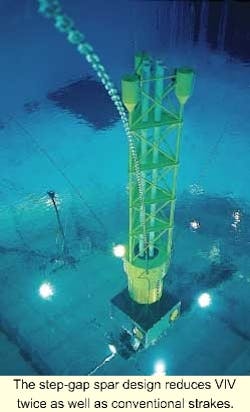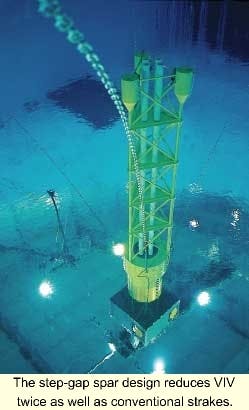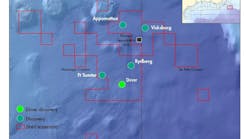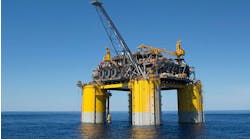SUBSEA TECHNOLOGY: Predicting downstream production riser VIV by vibration of upstream riser
The step-gap spar design reduces VIV twice as well as conventional strakes.
Among many considerations of deepwater drilling and production is the phenom-enon of vortex induced vibration (VIV), a cyclic motion brought about by current flows around vertical cylinders and other similar forms. While much is known about how currents and cylinders interact in shallow water, deepwater operations have presented other factors and influences.
The deepwater Gulf of Mexico, with its multiple currents, has provided a significant opportunity for Shell to study conditions and model the effects of VIV in deepwater.
Much of what the oil industry places in the offshore environment is made up of cylinders. Don Allen, Research Engineer with Shell International E&P, explained VIV in the following manner:
- Friction along the cylinder surface slows the flow around it. Eventually, it cannot overcome the pressure on the downstream side of the cylinder, so the flow separates. The fluid farther away from the cylinder wall moves faster than the fluid next to the cylinder, forming a boundary layer.
- At very low Reynolds numbers (velocity times diameter over kinematics viscosity), there is a standing vortex pattern.
- Once the vortex forming on one side of the cylinder becomes stronger than the vortex generated by other side, it builds quickly, overtaking the other vortex.
- Eventually, the vortex entrains the shear layer on the other side of the cylinder. In turn, this vortex continues to build until it sheds away from the cylinder.
- Once it has entrained the opposite sheer layer, it is entraining fluid that is rotating in the opposite direction, coming off the other side of the cylinder.
- When the vortex does this, a pressure spike develops and it propels water downstream (vortex shedding).
- Once the stronger vortex sheds, it loses energy and becomes the weaker vortex, allowing the vortex on the other side to build, entrain, and shed.
As this cycle continues, Allen says it creates a pattern of vortex shedding, known as the Karman Vortex Street. In this situation, there is a figure eight force imposed on the cylinder.
Motion response
"If the cylinder is free to vibrate, it will vibrate in a figure eight," he said.
Because many of the cylinders in the field have different stiffnesses and geometries, their motions are not so clean-cut. Allen said the motion can sometimes resemble a crescent moon. For a VIV problem to develop, there must be a restoring force, otherwise it is a forced vibration problem, not a resonance problem.
The typical offshore cylinder, such as a riser pipe, has a restraining force at each end (jacket, wellhead, etc.). This encourages the resonance, when the vortex shedding frequency matches one of the natural frequencies of the structure. When that happens, the vibration grows.
The only thing initially stopping it is damping. Unlike most vibration problems, once the cylinder begins to move, it gradually destroys the boundary layers around it. When it destroys this pattern, it self limits at about one-and-a-half diameter amplitude, which is three diameters peak to peak.
Many modes
In shallow water, the industry typically deals with first mode vibrations: the entire cylinder is moving in one direction, then another, in a full arc. In second mode or greater, there is more than one curve involved to the point that in a 30th mode vibration, the cylinder would resemble a squiggly line. While it has long been understood how to calculate these first mode vibrations, the higher modes are more difficult.
"As we move into deepwater, we recognized that we don't have first mode vibration anymore," Allen said. In deepwater, the problem is more complicated. One reason for this complication is that the long (deep) cylinder has a sheared current profile that may drop as low as zero before it reaches the bottom. The natural frequency of the cylinder is inversely proportional to its length. So, instead of exciting simple first-mode vibrations, vibrations on these deep risers may be 40th mode or higher.
Because there are so many modes that can respond up and down the cylinder, it becomes difficult to calculate the effects of currents on the cylinder:
- Will all these respond at once?
- How will they contribute to the vibration?
- What will the vibration be?
On top of this, as projects move into deeper water, the currents become worse. Reliable prediction becomes critical to the success of high-dollar projects in deepwater.
Tackling higher modes
Research early on was able to test vibration problems as high as fourth mode, but not any higher. To address these problems required modification of Shell's test tank facilities. Allen had an additional 50-ft added to the depth of the tank, in the form of a 50-ft caisson. The column of water was narrowed and lengthened within the tank, so that it allowed for the testing of 60-ft-long cylinders.
Tests then showed there could be single-mode dominance under even very strong sheared flows. This is important because it means one mode would eliminate problems caused by the others. While this mode would be expected to be much larger and stressful than the combined modes, if this mode could be identified, it could be guarded against. In addition, timing the vibration was still difficult to predict. Still, Allen said this discovery made it possible to "bound" the problem.
Downstream cylinders
With deepwater production, there is typically at least one cylinder located downstream of others. How does this affect the VIV? Allen said most people did not believe there could be a model to predict this phenomenon. Allen said he took this as a challenge and his model was supported by 1,200 tests conducted to verify its results.
"We can actually predict the vibration of a downstream cylinder, given the vibration of an upstream cylinder," Allen said. His model will be published later this year. The next challenge was to model this vibration in the presence of high Reynolds numbers. Allen said this has also been overcome.
VIV Suppression
For steel catenary risers in the Gulf of Mexico, VIV suppression is a must. Allen and his Shell colleagues have performed tests on a whole range of VIV suppression devices and the various parameters of the individual devices. From these experiments came a number of revolutionary designs. For example, these experiments produced the ultra-short fairing. "That's the most used fairing in the world," he said.
This was a major gut check, since the fairings were used first on the Mars production risers, based on this experimentation. Allen said concerns with marine growth were overcome by the use of copper on the bearing surfaces. In addition, these short fairings handle marine growth better than regular fairings, and if for some reason they were to lock up and no longer rotate, they are small enough that the result is no worse than if there were no suppression at all.
On the Auger project it was initially assumed that $10-$15 million in VIV suppression devices would be needed on the production risers. Thanks to the refinement and greater confidence in the VIV modeling, Allen said, this figure was reduced to zero.
New designs
In addition to saving money by predicting VIV, Allen's research has led to a number of new designs. Among these is the step-gap spar, which Shell has designed to be twice as effective against VIV as a traditional spar with strakes.
While this spar appears more complex in design, Allen said it is actually easier to fabricate than a traditional spar design. The cylinder itself is divided into two sections with a gap in between. This gap, located well below the surface is the key to reducing the vibrations. Below the second hull section of the main body is an open truss with triangular steps installed at regular intervals.
At the base of the truss are three large tanks, one in each corner. The truss and steps protect the risers, which run up the center of the structure and also limit hull motion. This design was tested and found to reduce the transverse-sway VIV motion to about 25% of the hull diameter. Shell is considering using this design in the Gulf of Mexico and Northern North Sea.




